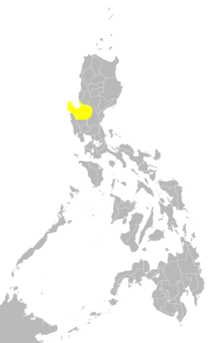
Back Pangasinan Afrikaans ፓንጋሲናንኛ Amharic بانجاسينان ARZ Idioma pangasinense AST پانقاسینانی دیلی AZB Tataramon na Pangasinense BCL Pangasinan Catalan Pangasinan-ngṳ̄ CDO Pangasinensische Sprache German Pangasina lingvo Esperanto
This article needs additional citations for verification. (October 2011) |
| Pangasinan | |
|---|---|
| Pangasinense | |
| Salitan Pangasinan | |
| Pronunciation | [paŋɡasiˈnan][1]: 36 |
| Native to | Philippines |
| Region | Ilocos Region (entirety of Pangasinan, southwestern La Union) Central Luzon (northern Tarlac, northwestern Nueva Ecija, northern Zambales) Cordilleras (southwestern Benguet) Cagayan Valley (southwestern Nueva Vizcaya) |
| Ethnicity | Pangasinan |
Native speakers | 1.8 million (2010)[2][needs update] 8th most spoken native language in the Philippines[3] |
Austronesian
| |
| Latin (Pangasinan alphabet) Historically written in: Kurítan | |
| Official status | |
Official language in | Pangasinan |
Recognised minority language in | |
| Regulated by | Komisyon sa Wikang Filipino |
| Language codes | |
| ISO 639-2 | pag |
| ISO 639-3 | pag |
| Glottolog | pang1290 |
| Linguasphere | 31-CGA-f |
 Areas where Pangasinan is spoken in the Philippines. | |
Pangasinan (Pangasinense) is an Austronesian language, and one of the eight major languages of the Philippines. It is the primary and predominant language of the entire province of Pangasinan and northern Tarlac, on the northern part of Luzon's central plains geographic region, most of whom belong to the Pangasinan ethnic group. Pangasinan is also spoken in southwestern La Union, as well as in the municipalities of Benguet, Nueva Vizcaya, Nueva Ecija, and Zambales that border Pangasinan. A few Aeta groups and most Sambal in Central Luzon's northern part also understand and even speak Pangasinan as well.[4]
- ^ Benton, Richard A. (1971). Pangasinan Reference Grammar. Honolulu: University of Hawaii Press. ISBN 978-0-8248-7910-5.
- ^ "2010 Census of Population and Housing, Report No. 2A – Demographic and Housing Characteristics (Non-Sample Variables)" (PDF). Retrieved 2022-05-02.
- ^ "2010 Census of Population and Housing, Report No. 2A – Demographic and Housing Characteristics (Non-Sample Variables)" (PDF). Retrieved 2022-05-02.
- ^ Ulrich Ammon; Norbert Dittmar; Klaus J. Mattheier (2006). Sociolinguistics: an international handbook of the science of language and society. Vol. 3. Walter de Gruyter. p. 2018. ISBN 978-3-11-018418-1.